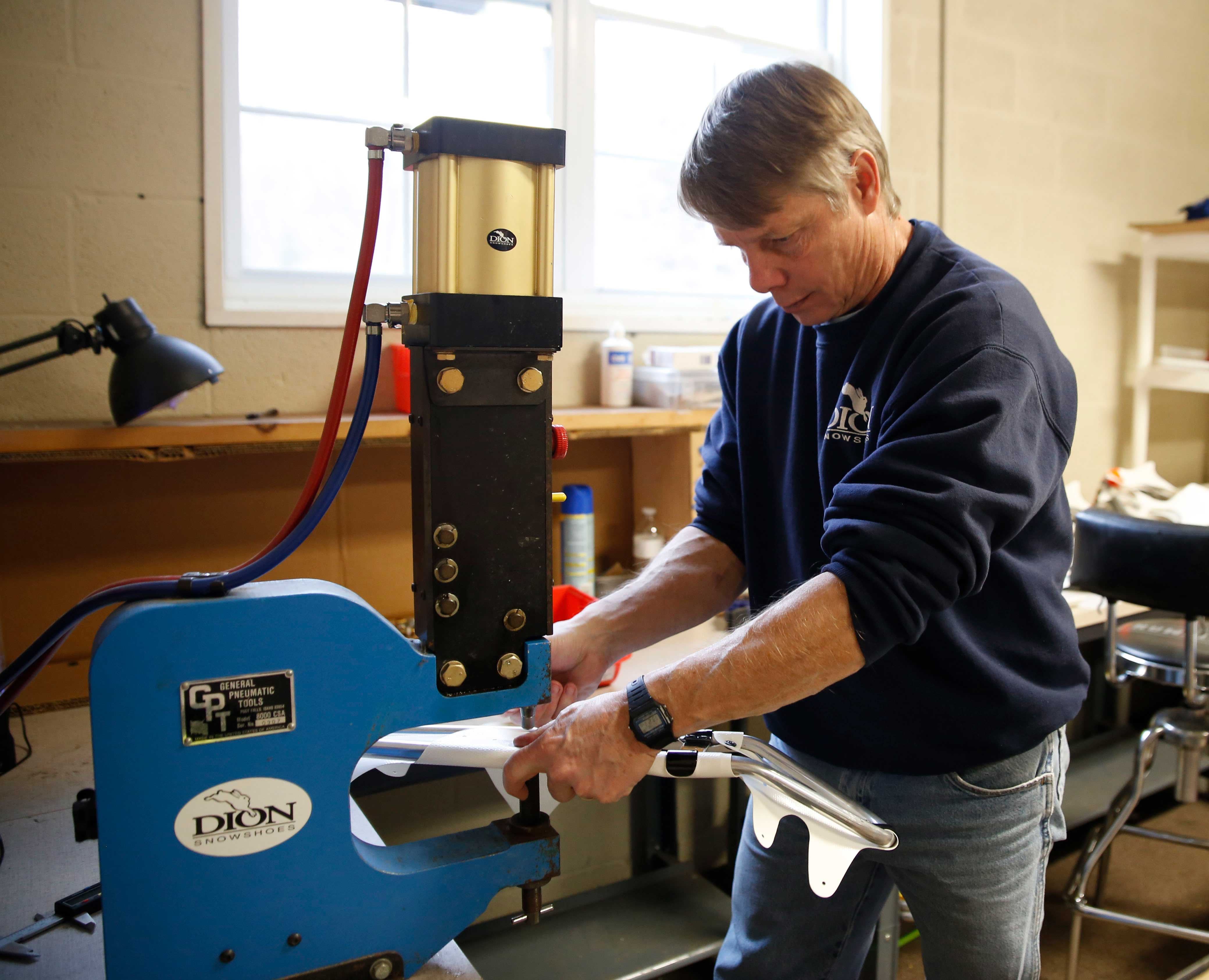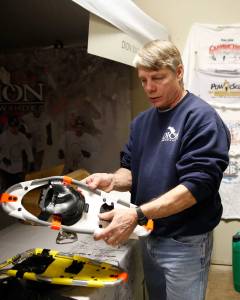
By Larry Parnass
Bob Dion comes across as a keep-your-head-down guy, a problem-solver. He’s a Point A to Point B type, because that’s how people in a hurry view geography.
When Dion’s in a hurry, that might well be him coming up fast behind you, his stride compact and strong, snowflakes flying.
When he blows right by? Don’t feel bad, because he’s someone Trail Runner Magazine named one of the 10 “living legends of trail running.”
When I caught up with the legend, he was leaning over a work table inside a North Bennington factory complex and speaking with Tonya Van Buren, an employee at Dion Snowshoes. It was the week before the start of the racing season.
Racks in the big room were filled with inventories of completed snowshoes of varied sizes and purposes, all carrying the company’s distinctive fluorescent orange toe tag.
When Dion studies photos taken at the finish line of snowshoe races, that’s what he’s looking for.

Those orange tags are usually there, evidence of his company’s success.
This time of year, as he travels the racing circuit, Dion’s viewed as a rock star in a demanding sport most people know nothing about. Snowshoe racing exists somewhere between mountain unicycling and roller derby in popularity, but its reputation is growing, thanks in large part to Dion and his wife, Denise.
In early March, the Dions and their company will again host the U.S. National Snowshoe Championships, this time in Woodford, Vt.
It will bring a growing community of snowshoe racers to the sport’s spiritual heart, and within miles of the modest plant that turns out the specialty snowshoes worn by the majority of racers in the eastern U.S.
Since the start of the racing season in December, the Dions have hit the road to attend competitions across the Northeast, drawn both by the need to nurture their business and a call to the wild of winter trail racing atop the gear they sell across the country. The company sponsors over 100 races in seven separate series. A map of the northern U.S. on one of the factory’s walls shows carries pinpricks identifying race locations.
But they also go to races because they love the sport that loves them back.
Denise Dion, herself a snowshoe racer who’s won gold and silver medals at national competitions, says the pull to leave the merch table behind while attending races is powerful.
“They all take off, and we want to take off too,” she said.
Like a lot of distance runners, Bob Dion, 62, has learned to be comfortable with his own thoughts. His stories tend to be succinct and rarely award him any credit, despite the recognition he’s received — including two golds, two silvers and a bronze medal in national snowshoe competitions and countless other awards in races ranging up to 100 miles on roads, trails and tracks.
He’d been a runner for years before his introduction to the snowshoe race, nearly 20 years ago, that may have changed his life.
“I won the first one I did. I thought, ‘Oh, I love this,’” Dion says.
But his inventor’s gene was restless. Early snowshoe racers clomped along in heavy gear designed for backwoods travel by hunters and maple-sugarers. But snowshoes then were so long they threw snow up and so wide they banged against ankles. Racers would tape cardboard to their ankles to protect them, Denise Dion says.
“There weren’t any decent snowshoes for racing,” Bob Dion says. “They slopped around and moved around a lot.”
Within a few years, Dion pulled away from a job in Amherst, Mass., and began making his own brand of snowshoes designed specifically for racing, starting at the couple’s home in Readsboro. He wanted them to be light, small and indestructible and stand up to trail conditions racers encounter across unpredictable New England winters.
That meant tough components that, he reasoned, could be switched out and replaced quickly, so racers didn’t find themselves without gear as the next contest approached.
Tough stuff, in other words.
“We’ve got roots, rocks and mud,” he says. “There’s a lot of abuse.”
Customers took note and his shoes began to sell, first under the Catamount name and then with his own, in a logo adorned with a leaping snowshoe hare.
As the business grew, it faced off with other manufacturers interested in the racing niche, including Atlas Snow-Shoe Co. of Seattle, for a time one of its main competitors.
Tubbs, another Vermont company, was also out there, though focused more on recreational use, but selling shoes for less than the range Dion charges, from $200 to $300 a pair.
Along the way, both of the other companies were bought out and their production moved to China.

The Dions keep a wary eye out across the market. Though there are few competitors, the sport is so small there isn’t much business to share. A main rival now is Northern Lites.
The Dions work hard to be the dominant player in the Northeast and claim to have 60 to 80 percent of the racing market in the region and Canada, and 40 percent out west. Last year’s national competition, which the Dions’ company also sponsored, was held in Bend, Ore.
They’ve become the team to beat at the cash register, and the competition pays to play, covering travel and lodging for top racers in exchange for using their gear.
As competitors to the core, the Dions aren’t ones to sit still for it. “We can’t have anybody sponsor in our backyard,” Bob Dion said.
The couple works to reinforce their brand by driving merchandise personally to running and bike shops, their prime retail outlets. Customers tend to be people who want a physical challenge, and are willing to pay a premium for the right equipment.
Given his natural reticence, it took a while for Bob Dion to agree to put his name on shirts and other accessories.
But to his amazement, the stuff sells. “Now, anything with our name on it, people are buying. Why would people want to wear anything with my name?” he asks.
Like any winter sport, success for a gear supplier depends on the weather. The Dions say that even with a committed clientele, sales tend to slump in years after winters with scant snowfall. That was the case for the winter of 2016-2017, and like hundreds of businesses in Vermont, the Dions have been fervently thinking snow.
They need steady sales through the winter to help them get through summer. It remains a lean business.
“We’re doing a little bit better every year with sales,” Bob Dion says. “The seasonal part of it is horrible. We barely get enough to get through the summer.”
The product line includes four types of frames, of different sizes and weights, with different bindings and cleats. They brought out a narrower cleat option this year.
Some cleats are made of stainless steel. Others are aircraft aluminum with a Teflon coating.
Another innovation the Dions introduced was to make the Velcro binding straps adhere more surely, even in a hurry.
From the start, the Dions have made snowshoes their own way, skipping use of the traditional toe basket because it doesn’t allow the racer’s weight to come down in the right place, they say.
At first, they sent pieces of aluminum tubing out to be bent into the parts that make up the shoe’s frame, to be later joined by special aircraft epoxy. After investing more than $8,000, the company now has its own a pipe bending machine, a long and sleek gizmo that owns a corner of the factory floor.
Once frames are assembled, the decking — a coated fabric akin to the substance used for inflatable kayaks — is riveted on and then other components are attached.
Unlike street shoes, you see is what you get with a snowshoe, and it’s all about function.
After nearly 20 years of making snowshoes, the Dions know their craft, and the special principles they follow.
“Somebody can’t just come in and do it the way we’re doing it,” Bob Dion says.
And even if they do, just try keeping up with them on the race course.
The DION WMAC Snowshoe Series Winter
For more information, go to dionwmacsnowshoe.com
Jan. 7 – Winter Magic 5k+ Londonderry, Vt.
Day-of registration only
Jan. 14 – WSSF North American Championship 5/10k Saranac, N.Y.
Day-of registration only
Jan. 20 – Hoot Toot & Whistle 5k Readsboro, Vt. .
Day-of registration only
Jan. 27– Western Mass Snowshoe Scramble 5k/10k Holyoke, Mass.
Online registration
Feb. 4 – Saratoga Winterfest 5k Saratoga Springs, N.Y.
Online registration or paper registration
Feb. 10 – Camp Saratoga 8k Wilton, N.Y.
Online registration or paper registration
Feb. 11 – Capital Hills 5k #2 Albany, N.Y.
Online registration
Feb. 17 – Stone Bridge Caveman 5/10/15k Pottersville, N.Y.
Online registration
Feb. 24 – Brave the Blizzard 5k/5.5mi Guilderland, N.Y.
Feb. 25 – Woodford Whiteout 10k Woodford, Vt.
Online registration
March 3 – Garnet Hill 10k North Creek, N.Y.
Online registration
March 10 – US Snowshoe Nationals 5k/10k Woodford, Vt.
March 11 – US Snowshoe Nationals Relays/Half/Marathon Woodford, Vt.
Online registration
Larry Parnass prefers roads less traveled. He is the investigations editor of The Berkshire Eagle and former editor of the Daily Hampshire Gazette.












